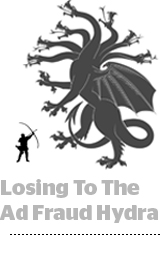 While the online advertising trade groups have created anti-fraud programs and exchanges have instituted inventory standards, fraud is still on the rise.
While the online advertising trade groups have created anti-fraud programs and exchanges have instituted inventory standards, fraud is still on the rise.
AdExchanger reached out to some of the people in the trenches about where the digital ad tech and media ecosystem stands now and how progress can be made. Click below for their responses.
To what degree has fraud been dealt with in any meaningful sense? Has the balance of power shifted between fraudsters and the online ad/media ecosystem?
Shailin Dhar: Fraud has only grown exponentially over the past four years, since I’ve been watching it closely. I don’t think the power has shifted at all. “Fraudsters” is such a vague term that we all use. Are we talking about actual fraudulent publishers? Or their fraudulent traffic vendors? Or the malware creators who create and operate the botnets which supply the traffic? They are all still growing because ad budgets are growing and they need to be spent somewhere.
Marc Goldberg: We’ve done a good job of trying to address the problem by putting companies and practices in place, but bad guys are better than we are. You can go buy a filter for a viewability vendor or an exchange platform from someone who’s reverse engineering that algorithm and is selling traffic to beat the platform.
Augustine Fou: Fraud is becoming less obvious and harder to detect. So the lower numbers you hear about is not because the fraud is lower, it’s because the measurements are catching less and less of it. This is especially true in mobile. Put simply, none of the Javascript-based fraud-detection tech can measure mobile (apps specifically); those require measurement SDKs. But obviously the bad guys don’t install fraud-detection SDKs in their mobile apps.
So where is fraud entering the supply chain now?
Ben Trenda: Look at performance. Why didn’t my performance increase when my DSP or SSP partners removed all the fraud? Because they didn’t – it’s just harder to identify now than it used to be. Conversely, when you proactively target a real human audience, you see performance increases north of 25%. That wouldn’t be possible if all the fraud was removed.
Michael Tiffany: Most fraud still comes from what I’d call “ad fraud classic,” which is publishers ordering visits or engagement from CPC vendors. But the elite of the desktop world have repurposed for the mobile web and mobile fraud models. So you see more consumer apps, like a flashlight or something gimmicky, with some claim to legitimacy that are really just built for fraud.
One of my new favorites are these zombie domains, where a bunch of applications are still trying to make calls to those domains, so people buy those domains or gain control over that traffic and then can inject ads or malware – and it’s surprisingly high-traffic.
And consider mobile web video advertising, which saw spending double while true ad insertions went up a bit, with the rest made up by mobile web visitors bloating video players with fake views.
Ad fraud is a shared burden, but not necessarily a fair one. Which stakeholders are most invested or in a position to actually counter fraud?
Goldberg: Agencies can play that role by leveraging multiple layers. When you introduce fraud-free guarantees, inventory drops off a cliff. So if the client continues to expect scale and lower rates, there’s friction. It’s up to marketers to recalibrate their expectations of scale and valuable inventory. It’s a buy-side education that needs to happen.
For instance, viewability and fraud are grouped together because they’re headaches for everyone, but they shouldn’t be. Viewability is a measurement and fraud is a criminal offense. It’s bringing knowledge and pressure to bear on agencies to not just want to check a box that will put their client at ease, but to actually manage fraud.
Tiffany: I’ve come to think that when enough marketers are diligent enough to tell the difference between getting what they pay for and being lied to, the sell side will invest in extraordinary fraud-prevention measures. At that point it turns into a competitive advantage. It doesn’t have to be perfect, just diligent enough to trigger competition on quality. So that’s not exactly like sharing the burden, it’s that buyers need to instigate.
Trenda: Companies are starting to validate [that] various first-party and third-party audience segments are real, both for marketing and other purposes. This upstream approach seems to be more impactful than focusing on impression fraud. High-quality publishers who are using third parties to generate traffic are doing the same thing to ensure they acquire a pre-verified human audience.
This post was syndicated from Ad Exchanger.

More Stories
Call for entries campaign for Gerety 2025
Friday, Feb. 21 Evening Cable News Ratings: Kaitlan Collins Is 1st in the Demo for CNN
Get closer to the action with Go Media’s new Game Frame